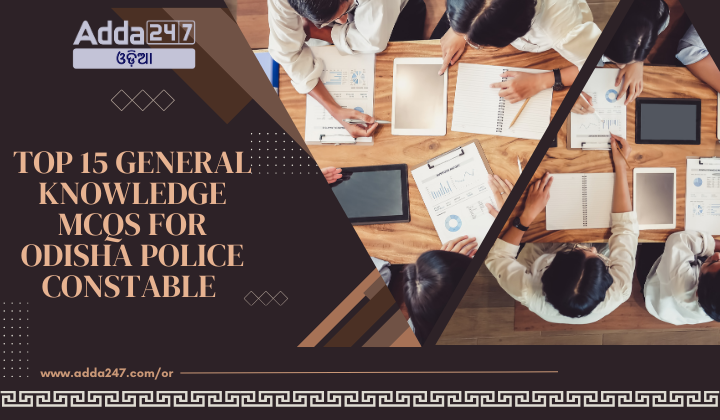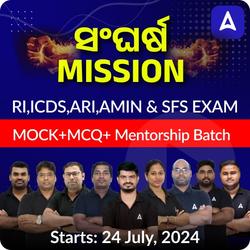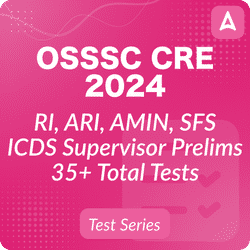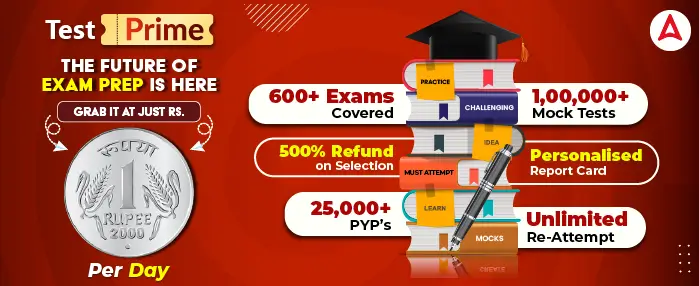Odisha Police Constable exams test aspirants on various subjects, including general knowledge, which plays a critical role in determining the candidate’s performance. Preparing for GK questions on topics such as Science & Technology, Polity, Awards, Odisha’s geography, and Current Affairs ensures a well-rounded understanding. This set of 15 general knowledge multiple-choice questions (MCQs) has been carefully curated to cover diverse topics such as the Constitution, Nobel Prizes, Census 2011, and key aspects of Odisha’s rivers, neighboring states, forests, and elections. By practicing these questions, aspirants can sharpen their knowledge to excel in the exam.
Top 15 General Knowledge MCQs For Odisha Police Constable
Q1 . Where is the village of Pipili located, known for its vibrant community of craftsmen specializing in applique craft?
(a) 20 km from Cuttack
(b) 20 km from Puri
(c) 20 km from Bhubaneswar
(d) 20 km from Konark
Ans: (c) 20 km from Bhubaneswar
Sol: Pipili is a village in Odisha, located 20 km from Bhubaneswar, renowned for its skilled craftsmen who specialize in the traditional applique craft.
Q2 . What is the local term for applique craft in Odisha?
(a) Patta Chitra
(b) Chandua
(c) Filigree
(d) Jhoti
Ans: (b) Chandua
Sol: In Odisha, the traditional applique craft is known as “Chandua,” an intricate fabric art involving the stitching of colored pieces of fabric onto a base material.
Q3 . Which form of painting in Odisha focuses primarily on religious themes and is executed on small strips of cotton cloth?
(a) Patta Chitra
(b) Filigree Work
(c) Muruja
(d) Jhoti
Ans: (a) Patta Chitra
Sol: Patta Chitra is a form of painting in Odisha that is predominantly based on religious themes, often portraying scenes from Hindu mythology, and is traditionally done on strips of cotton cloth.
Q4 . What is the main objective of the Odisha government’s recent genome sequencing of diphtheria-positive samples in Rayagada district?
(a) To identify new viral strains
(b) To enhance vaccine efficacy
(c) To identify new variants and understand transmission among vaccinated children
(d) To develop new antibiotics
Ans. (c) To identify new variants and understand transmission among vaccinated children.
Sol: The genome sequencing aims to detect new variants of the diphtheria bacterium and assess how the disease spreads among vaccinated individuals, helping authorities improve public health strategies.
Q5 . Which bacterium is caused by diphtheria?
(a) Streptococcus pneumoniae
(b) Corynebacterium diphtheriae
(c) Escherichia coli
(d) Mycobacterium tuberculosis
Ans. (b) Corynebacterium diphtheriae.
Sol: Diphtheria is an infectious disease caused by Corynebacterium diphtheriae, which primarily affects the mucous membranes of the throat and nose.
Q6 . What is a Glacial Lake Outburst Flood (GLOF)?
(a) A flood caused by the overflow of a river during heavy rainfall.
(b) A flood that occurs when water dammed by a glacial moraine is released suddenly.
(c) A flood caused by the melting of snow in high-altitude areas.
(d) A flood caused by an earthquake-triggered landslide.
Ans: (b) A flood that occurs when water dammed by a glacial moraine is released suddenly.
Sol: A GLOF happens when the natural dam created by a glacier or its moraine collapses or breaches, causing the sudden release of large volumes of water, which leads to flooding downstream.
Q7 . Which type of glacial lake is formed by water dammed by debris left by glaciers?
(a) Ice-dammed lake
(b) Moraine-dammed lake
(c) Erosion-based lake
(d) Subglacial lake
Ans: (b) Moraine-dammed lake
Sol: A moraine-dammed lake is formed when a glacier leaves behind debris, called a moraine, that acts as a natural dam, trapping meltwater and forming a lake.
Q8 . The Godavari River originates near which place?
(a) Nasik
(b) Nagpur
(c) Trimbakeshwar
(d) Mumbai
Ans: (c) Trimbakeshwar
Sol: The Godavari River, one of the longest rivers in India, originates from the Trimbakeshwar range in the Nashik district of Maharashtra.
Q9 . Which of the following rivers flows into the Arabian Sea?
(a) Ganga
(b) Yamuna
(c) Narmada
(d) Mahanadi
Ans: (c) Narmada
Sol: The Narmada River flows westward and empties into the Arabian Sea. It is one of the major westward-flowing rivers in India.
Q10 . The river Krishna flows through which states?
(a) Andhra Pradesh, Telangana, Karnataka, and Maharashtra
(b) Gujarat, Rajasthan, Madhya Pradesh, and Maharashtra
(c) Punjab, Haryana, Himachal Pradesh, and Delhi
(d) West Bengal, Bihar, Jharkhand, and Odisha
Ans: (a) Andhra Pradesh, Telangana, Karnataka, and Maharashtra
Sol: The Krishna River flows through these four states and is one of the longest rivers in India, contributing significantly to the water resources of these regions.
Q11 . Which one of the following is true about High Courts?
(a) It has original and appellate jurisdiction
(b) It enjoys the power of judicial review
(c) It acts as the court of law
(d) All the above
Ans. (d)
Sol: High Courts in India have original and appellate jurisdiction, the power of judicial review, and act as courts of law. They can hear cases in the first instance (original jurisdiction) and also appeals from lower courts (appellate jurisdiction). Additionally, they have the authority to examine the constitutionality of laws (judicial review).
Q12 . At present, how many high courts are there in India?
(a) 25
(b) 21
(c) 28
(d) 29
Ans. (c)
Sol: As of the latest update, there are 28 High Courts in India, including some with jurisdiction over more than one state or union territory.
Q13 . Which one of the following articles deals with the appointment of judges?
(a) Article 214
(b) Article 217
(c) Article 226
(d) Article 216
Ans. (b)
Sol: Article 217 of the Indian Constitution provides for the appointment of judges to High Courts. It specifies the qualifications, tenure, and conditions of appointment.
Q14 . High Courts issue writs under which article?
(a) 220
(b) 221
(c) 213
(d) 226
Ans. (d)
Sol: Article 226 empowers High Courts to issue writs for the enforcement of fundamental rights and for any other purpose. This power is broader compared to the writ jurisdiction of the Supreme Court, which is limited to fundamental rights under Article 32.
Q15 . The Chief Justice and other judges of the High Courts are appointed by which one of the following?
(a) Prime Minister
(b) Chief Minister
(c) Governor
(d) President
Ans. (d)
Sol: The President of India appoints the Chief Justice and other judges of the High Courts based on the advice of the Chief Justice of India, the Governor of the respective state, and sometimes the Chief Justice of the High Court.










